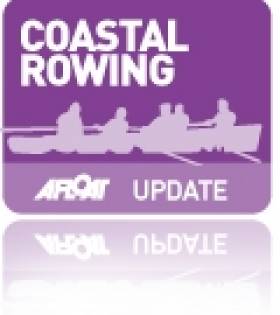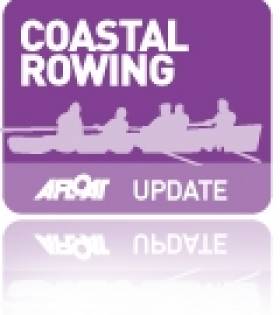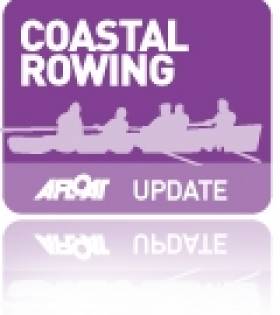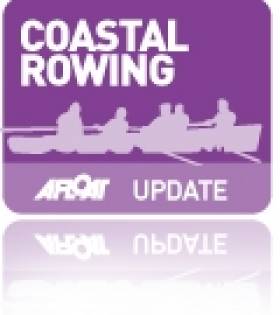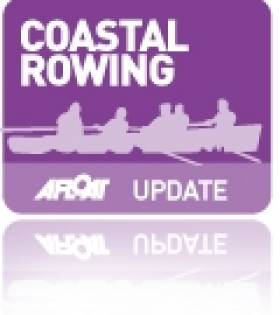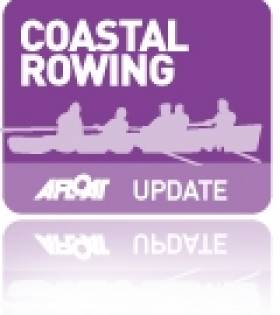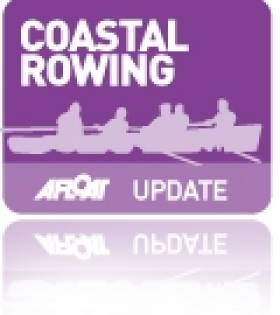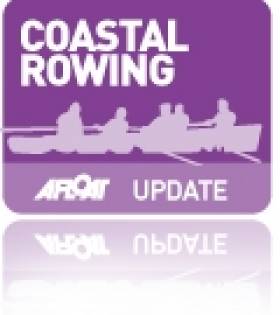Displaying items by tag: Coastal Rowing
Get an Oar's Eye View of Coastal Rowing
#Rowing - St Michael's Rowing Club in Dun Laoghaire has posted the above video giving an oar's eye view of one of their regular evening coastal rowing training sessions.
As the description says, the three-and-a-half-minute clip was shot with a miniature GoPro camera attached to the end of an oar which "caught they action from warm-up to interval training to clubhouse".
It's certainly a unique perspective - though maybe not suitable for anyone prone to motion sickness!
East Coast Rowing Council Announces 2013 Regattas
#CoastalRowing - The East Coast Rowing Council has announced its list of coastal rowing regatta fixtures in Dublin, Wicklow and Wexford for the 2013 season.
Commencing with the Greystones Regatta on 26 May, the schedule also includes events in Arklow (2 June) and Dalkey (9 June), the Stella Maria Regatta in Ringsend on 16 June and the Bray Regatta on 30 June.
July will see two events, the St Patrick's Regatta in Dublin's Docklands on 14 July and St Michael's Regatta off Monkstown and Dun Laoghaire on 28 July, while the Wicklow Regatta will mark the end of 2013's summer events on 5 August.
Locations of the various regattas and suggested viewing points are available HERE.
Flatpack Coastal Rowing Skiff Is All The Rage
#CoastalRowing - News comes from Scotland of an intriguing new coastal rowing craze that sounds like something from a Swedish furniture store!
As the Guardian reports, a traditional Scottish fishing skiff design provided the inspiration for the new flatpack coastal rowing boat, which began life as a prototype project for the Scottish Fisheries Museum four years ago.
Since then the St Ayles skiff concept swept like a wave across the UK and beyond - and examples of the DIY kit row boat, which is handmade in Fife, can be found as far afield as Australia.
Many of those international rowers are expected to converge in Scotland this simmer for the coastal rowing world championships off Ullapool.
The Guardian has much more on the story HERE.
Hobblers Set To Be Challenged!
Coastal rowing in Ireland is a varied sport, but early September sees a very special race come to the shores of Dublin Bay. At 28km, this is the longest annual single-crew rowing race in the country. Around a dozen crews will start from the Hobblers' Memorial in Dun Laoghaire harbour, leave the bay, round the Kish lighthouse, and pull back to the finish line at the harbour mouth in Dun Laoghaire, battling hard for the Hobblers' Challenge cup.
The 2012 Hobblers' Challenge will take place on Saturday 8th September, starting at 1.30pm at Dún Laoghaire's East Breakwater. The race is open to mens, ladies, or mixed crews, most rowing the traidtional wooden clinker-built east coast skiffs of the region. However, this year the event has been opened up to include a wider variety of boat types, from Currach to 6-oar Cornish Pilot Gig, to modern fibreglass designs, make the race even more colourful.
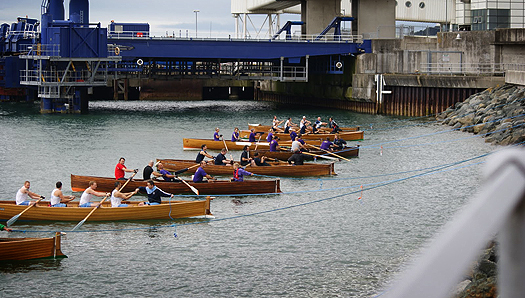
Lined up and ready at last years Hobblers Cup
Proudly organised by St. Michael's Rowing Club in Dún Laoghaire, The Hobblers' Challenge is an annual race run as a memorial to the hobblers of Dublin Bay, who during the 18th and 19th centuries invented what could be considered as the original rowing race. These men would leave Dún Laoghaire, Ringsend and other nearby harbours to meet ships arriving into Dublin. The first crew to the ship would win the business of pilotage and unloading, a tradition continuted by the east coast's 10 skiff racing clubs to this day.
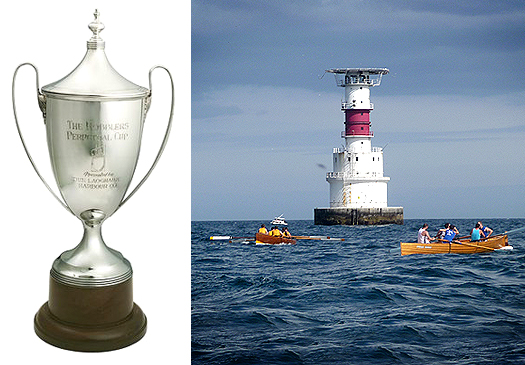
The Hobblers Perpetual Cup and crews racing to the Kish in last years event.
In 2010 Stella Maris Rowing Club took home the coveted cup with a time of 3hrs 3mins and 3 seconds from a field of 5 skiffs. 2011 saw their Ringsend neighbours St. Patricks Rowing Club take the cup in a time of 2hrs 57mins from a field of 10 skiffs. With 15 boats of varying types already entered at time of print, from Skerries in the north to Arklow in the south, 2012 promises to be a hotly contested race. Will the cup go back to Ringsend for a 3rd year running? Will the winning time be quicker again? Will one of the home crews mount a challenge? We'll find out very soon but what can be guaranteed is a fun day out.
Dún Laoghaire will also host the exciting MOD 70s race on the same day so there will be plenty to watch and get involved in on the East Pier. St. Michael's Rowing Club will be fundraising for the RNLI on the day. In 2011, over €1,600 was raised by the generosity of the people of Dún Laoghaire.

St. Michael's crew in action
Cold Wind, Huge Swells, Blisters, Exhaustion, Elation...The Toughest Celtic Challenge Ever
#COASTAL ROWING – During the May bank holiday weekend (4th-6th May), 12 men and women of St Michael's Rowing Club, Dun Laoghaire, participated in the biennial rowing race across the Irish Sea known as 'the Celtic Challenge'. It turned out to be what is widely regarded as the toughest crossing in the race's 19 year history, with just 12 of the 23 teams entered crossing the finish line unaided. St. Michael's finished 12th in the longest time ever taken for the 150km course – 27hrs, 18 mins, 21 seconds. The relay race is billed as the longest 'true' rowing race in the world and is listed as such in the Guinness Book of Records.
The run up to the event was challenging in itself with the team working tirelessly to secure a replacement support boat due to damage to the mast of the yacht that had already been confirmed. With just two days to departure, all the pieces of the puzzle were in place.
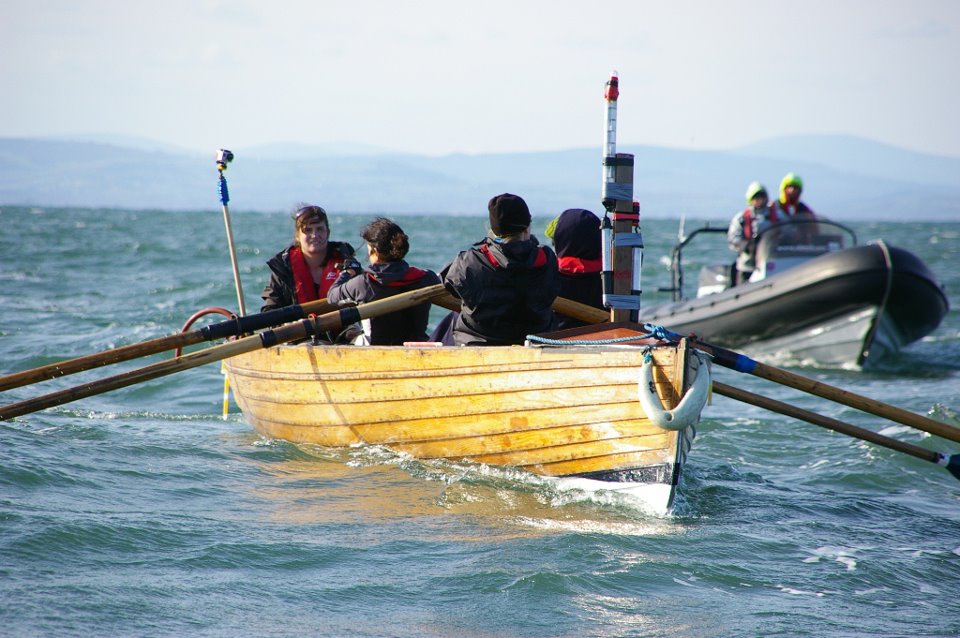
Pushing hard with a safey RIB keeping a watchful eye
Due to poor weather conditions, the race was postponed a number of times and eventually set off from Arklow, Co. Wicklow on Saturday 5th May at 4pm. Very soon after the start, the team from Bray Rowing Club who were rowing the only other traditional east coast skiff in the race had pulled out due to damage to their support boat, meaning that St. Michael's were the only wooden boat left in the race.
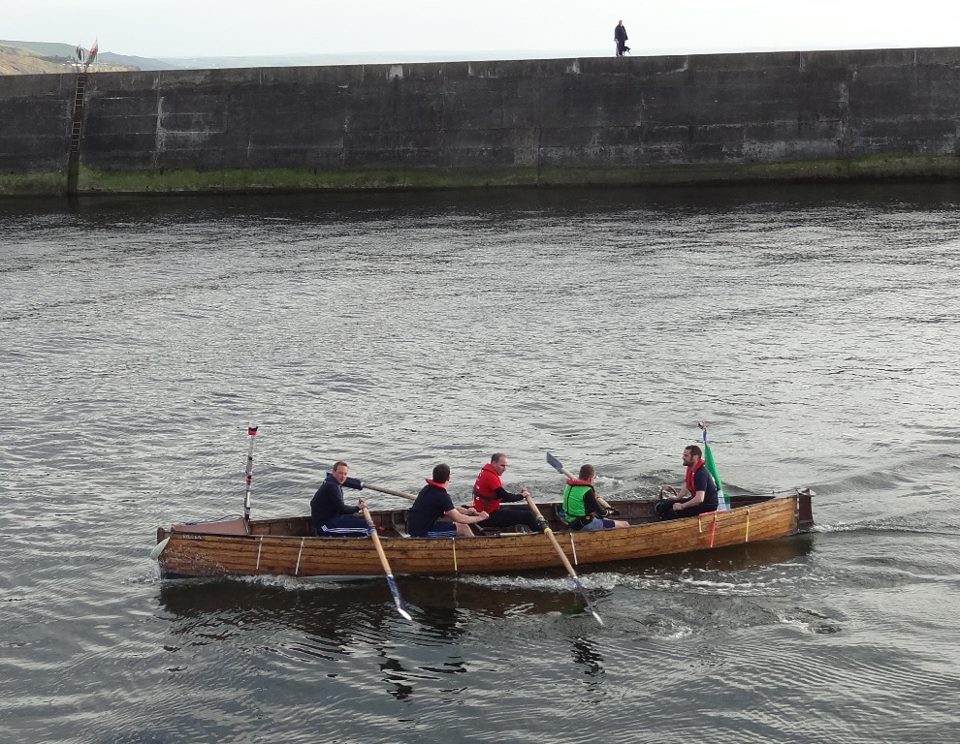
Over the line in Aberystwyth
The format of the race is a relay. Each team has 3 crews of 4 rowers that rotate their time on the oar, resting and refuelling on an accompanying support boat. Generally 'one hour on, two hours off' is the rule of thumb, but conditions, strategies, injuries, and sickness may dictate otherwise. The first 6 hours were the toughest and most challenging physically, as the northeast wind and swells created extremely challenging conditions for the participating rowers. The start was choppy and the Arklow Bank lived up to its reputation of being an extremely tough obstacle, but St. Michaels' quarter-ton clinker built skiff was well suited to the conditions. The solid wood oars used are three times heavier than carbon fibre equivalents used by all other teams, requiring strength and a particular technique even in normal conditions.

Exhausted but delighted
As the sun set, the crew knuckled down to what would be a tough, night-time row with changes of crew every hour. Their support yacht, the Helcia and the crew of the rib, the Wizard worked tirelessly to ensure the safety of the teams during the changeovers, both crewed by quite remarkable and extreme professionals, who gave freely of their time to the cause and to whom the club is eternally grateful. Working in two to three metre swells made rowing tough, and required 100% concentration and complete focus.
As the sun rose, it was clear the race was going to be a long one. Extreme conditions overnight meant teams hadn't travelled the distance they expected and knew they had to dig deep and work very closely as a unit to ensure spirits were kept high. As the changeovers continued and the hours flew by, the crew could see land, and somewhere in the distance was Aberystwyth. At this point, news of the night's retirements began to filter through on the VHF radio, with tales of other teams forced to pull out or turn back due to reasons including mechanical failure of support boats, sea sickness, damaged boats, lost rudders, and so on.
The final changeover was made at around 6.30pm on Sunday, and the pier could be clearly seen with cheering voices being carried on the wind. On the slip after the finish, the organisers and other crews were clearly impressed with the 30-year old 'Eileen' and her brave crew. At the awards ceremony the following day, St. Michael's became the first Irish team to be awarded the prestigious 'Spirit of the Celtic Challenge' trophy, which is given to the team which displays the greatest amount of endeavour when completing the course. This was a very proud moment for all the team as well as their friends, family, and all their clubmates back home in Dun Laoghaire.
First time Celtic Challenger was Wales born Gareth Whittington, now living in Dun Laoghaire told us, "I was told you never know what to expect as each Celtic Challenge is different because of the changing weather conditions, but I cannot and will not ever forget the way we pulled together as a team to ensure we got to Aberystwyth, an remarkable achievement".
Camaraderie between the Welsh and Irish clubs and teams involved is huge, but the team's thoughts that weekend were with the teams that did not make it, particularly their fellow Irish teams from Bray Rowing Club, Team Marie Keating, Ferrycarrig Rowing Club, and Airport Police and Fire Service Rowing Club. Congratulations are also due to the other Irish teams who crossed the finish line, Courtown, Foyle, and Arklow Rowing Clubs, the latter two of which won their respective categories.
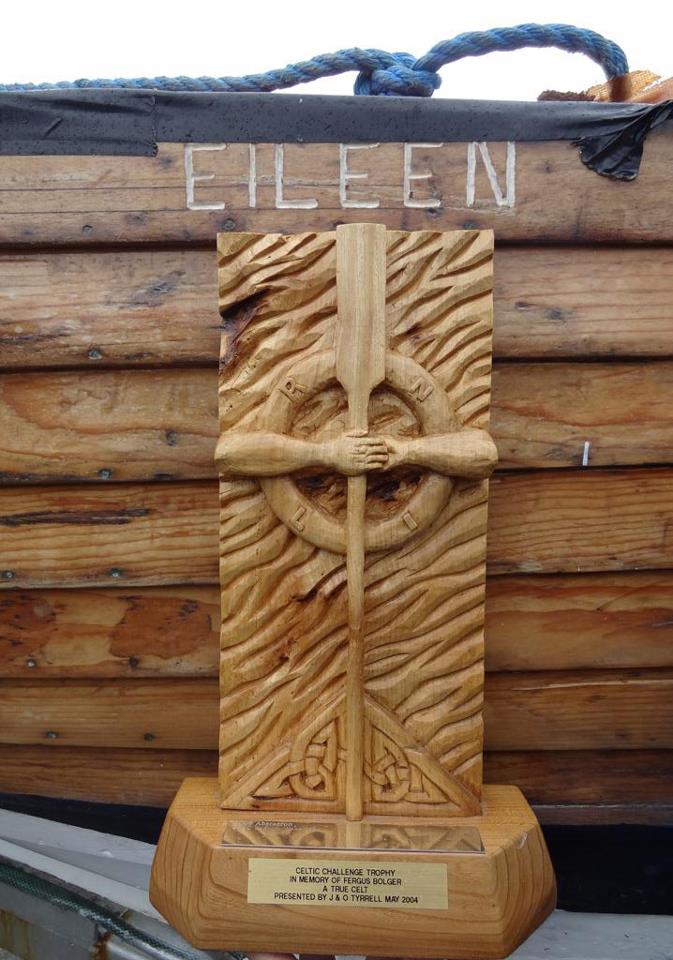
Spirit of the Celtic Challenge Award
St. Michael's participated in the Celtic Challenge to actively seek sponsorship, in a drive to raise funds towards new clubhouse facilities in Dun Laoghaire Harbour. Currently, the club lacks space to store their three wooden boats, space for indoor training, and is without changing facilities for the men, women and children who row for the club. It is hoped that the money raised can be put towards achieving this long-standing goal and keep the club's traditions and the tradition of the Celtic Challenge alive.

St. Michael's 2012 Celtic Challenge crew
#ROWING – St. Michael's Rowing Club has run into a problem with its Celtic Challenge this weekend after a support boat required to participate in its race across the Irish Sea has been damaged in this week's strong winds, leaving the Dun Laoghaire crew out of the race unless a replacement vessel can be found.
The club is looking for the use of a motor yacht – 33ft or bigger – with or without skipper/crew to help a team of men and women row across the Irish Sea on the Bank Holiday weekend of 4th-6th May.
The support yacht is used to house 2 crews of 4 at a time, with our RIB ferrying crews hourly between the yacht and the rowing boat. All fuel, transport and accommodation will be paid for by the club.
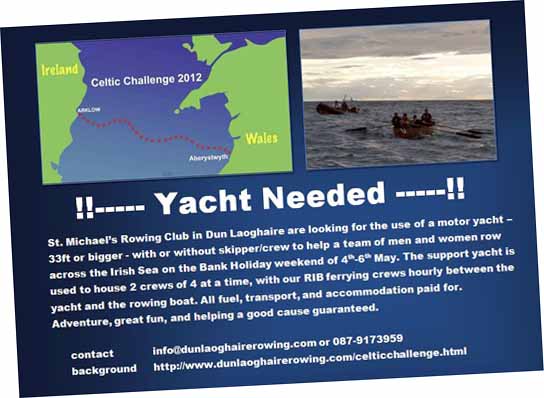
"I know it's short notice but we would cover costs and do not necessarily need a skipper to get us there as we have somebody ready to take that forward' says the club's Gareth Whittington. 'Adventure, great fun, and helping a good cause is guaranteed' he adds.
Contact [email protected] or 087-9173959 if you're interested or know someone who might be.
#COASTAL ROWING – Over the coming May bank holiday weekend (4th-6th May), 12 men and women of St Michael's Rowing Club, Dun Laoghaire, will take part in a biennial rowing race across the Irish Sea known as 'the Celtic Challenge'. The race sets off from Arklow, Co. Wicklow with the finishing line in Aberystwyth, Wales. At 150km, this relay race is billed as the longest 'true' rowing race in the world and draws together 27 teams from Wales, Ireland and beyond. The team is taking on this challenge to raise funds for a clubhouse in Dun Laoghaire, for the first time in the club's 90 year history.
Not many races start and finish in different countries, a source of pride to the Welsh and Irish oarsmen and women involved. So too is the sport of coastal rowing itself, which differs from the Olympic or 'Oxford-v-Cambridge' code of rowing in a number of key ways. Seats are fixed, not sliding, and boats are of a more substantial construction to tackle the swell on the open seas, which can reach several metres.

A St. Michael's boat and crew in training for the Celtic Challenge Cox: Tania Hashmi, Nicola Fitzgerald, Sam Nagle, Kathryn O'Leary, Julia Boyle
St. Michael's take things a step further by using quarter-ton wooden clinker-built east coast skiffs rather than the modern fibreglass models, used by all other competitors in 2010. Their solid wood oars are three times heavier than carbon fibre equivalents, requiring strength and a particular technique. In common with other clubs of Dublin and Wicklow, these boats originate from the 'Hobblers' of old; crews of local men who would engage in unlicensed pilotage of merchant shipping.
Their neighbour in Dun Laoghaire, the now seasonal HSS Stena Explorer consumes 20,000 litres of fuel per hour in crossing the Irish Sea. The St. Michael's squad will be powered by pasta, fig rolls, and energy drinks. But far from taking any moral high ground, the rowers will be glad of the ferry for the return journey home.
Each competing team in the Celtic Challenge consists of three rotating crews of four rowers and is accompanied by a support boat for navigation and for accommodating the resting crews. Changeover strategy is down to each team, but most opt for a one-hour-on, two-hours-off format. Depending on weather conditions, the race may start in Arklow on the afternoon of the Friday, Saturday or Sunday. Crews row through the night, arriving in Aberystwyth the following morning or afternoon.
The squad are actively seeking sponsorship for the challenge, in a drive to raise funds for a new clubhouse in Dun Laoghaire Harbour. Currently, the club lacks space to store their three wooden boats, space for indoor training and is without changing facilities for the men, women and children who row for the club. It is hoped that the money raised can be put towards achieving this long-standing goal.
The event is unique, very challenging and will test the 12 men and women taking part, both mentally and physically. Their oarsmen and oarswomen will have to contend with waves, currents, blisters, seasickness, lack of sleep and the particular challenges of rowing in the dark. The crossing is expected to take over 20 hours, with the St. Michael's Squad currently training hard on land and sea in preparation.
Some of the 2012 squad have made the crossing before, with others new to the event. One such first-timer is Wales born Gareth Whittington, now living in Dun Laoghaire who is relishing the prospect of a free ticket home, "I've been told since I moved here that Welshmen are just Irishmen who couldn't row west to the Promised Land, so I've something to prove to my Irish teammates!"
Bantry 2012 Launches 'Seamanship Challenge' this Month
#BANTRY2012 – A spectacular display of seamanship for Cork this Summer will be officially launched by Minister for the Marine Simon Coveney TD on January 27th when details of the Bantry 2012 Challenge are revealed. As well as a top sporting story organisers say it's also a tale of how tight knit coastal communities across the world have forged strong interantional links thanks to an initial idea in West Cork.
300 competitors from 16 nations are expected in July when replicas of the Bantry Bay longboat, the oldest surviving vessel in the French navy are raced under sail and oar.
The international crews will take part in a week long event in ten events both on and off the water. The prestigious event for the West cork venue is known as the 'Atlantic Challenge Bantry Bay Gig World Championships'.
Two years ago, as previously reported in Afloat, the Bantry Bay crew, soared in second place, while representing Ireland in the Atlantic Rowing Challenge in Midland Canada.
Competing on Lake Huron, one of the five Great Lakes the Bantry Bay Crew displayed huge amounts of physical and mental strength as they accomplished first place in their first three races.
The Atlantic Challenge is held every other year and sponsors a friendly contest of seamanship in Bantry Bay gigs. Founded by an American native Lance Lee, the Atlantic Challenge aims to build trust among nations and form a community of youth and adults from many countries, while also encouraging the practice of traditional maritime skills.
The boats measure almost 40-foot in length and hold 13 crew. Each boat uses a mainsail, foresail and mizzen.
The competition starts in Bantry on July 21st.
Irish crews had a good first day at the Fisa World Coastal Rowing Championships in Bari in Italy. John Keohane, who is defending his crown in the men’s single, qualified through the heats for tomorrow’s A Final, as did Monika Dukarska and Sheila Clavin in the women’s single. The men’s coxed quadruple from Kilmacsimon saw their hopes disappear in an instant when their bowman broke an oar in their heat. They came home down the field with just three men rowing, but went on to win their C Final last evening.
Fisa World Coastal Rowing Championships, Bari, Italy Day One
Men
Quadruple, coxed – Heat Two (1-8 to A Final; 9-16 to B Final; rest to C Final): 1 Bayer Leverkusen, Germany 20:55.60; 18 Kilmacsimon (S Bennett, S O’Neill, K O’Dwyer, E O’Neill; K O’Leany) 27:56.60. C Final: 1 Kilmacsimon 26:03.50.
Double – Heat Two (1-6 to A Final, 7-12 to B Final; 13-18 to C Final; rest to D Final): 1 Elpis Genova, Italy 21:45.80; 14 Kilmacsimon (D O’Donovan, R Farrissey) 30:48.00. C Final: 6 Kilmacsimon 31:30.70.
Single – Heats (1-8 To A Final; 9-16 to B Final; rest to C Final) – Heat One: 1 Trieste, Italy (S Martini); 11 Arklow (E Kavanagh). Heat Two: 1 Cus Pavia, Italy 24:34.90; 6 Kilmacsimon (J Keohane) 25:24.60.
Women
Double – Heats (1-6 to A Final; rest to B Final) – Heat One: 1 Aviron Hennebont, France 26:23.50; 8 Arklow (D Maghery, Y Jordan) 34:04.30. Heat Two: 1 Aviron Grenoblois, France 26:47.10; 8 Kilmacsimon (H O’Neill, L O’Neill) 38:15.20.
Single – Heats (1-6 to A Final; rest to B Final) – Heat One: 1 Murcarolo, Italy 30:20.60; 3 St Michael’s (S Clavin) 33:12.50, 8 Arklow (J Ni Ghormain) 39:02.00. Heat Two: 1 Societe Nautique D’Avignon 29:19.90, 2 Killorglin (M Dukarska) 30:38.90; 8 Arklow (J Lee) 42.01.80.
Bantry Crew in Second in 'Atlantic Challenge'
The Bantry Bay crew, soared in second place, while representing Ireland in the Atlantic Rowing Challenge; International Contest of Seamanship in early August this year in Midland Canada.
Competing on Lake Huron, one of the five Great Lakes the Bantry Bay Crew displayed huge amounts of physical and mental strength as they accomplished first place in their first three races.
The Atlantic Challenge is held every other year and sponsors a friendly contest of seamanship in Bantry Bay gigs. Founded by an American native Lance Lee, the Atlantic Challenge aims to build trust among nations and form a community of youth and adults from many countries, while also encouraging the practice of traditional maritime skills.
Over the duration of the competition, the crew all from Bantry in West Cork placed well in all events but disaster struck when a mast step shattered just before the start of the Oars and Sails race, one of the team's better disciplines. The crew using their initiative and experience managed to fix the mast and crossed the start line under sail, ten minutes after the other crews had started. In 13th (and last) position, a huge performance was needed to regain the lost ground and, again, the Bantry crew pulled out all the stops and produced an inspiring display of courage and stamina picking off each of the other competitors one by one. The ten minute delay at the start fuelled this determination and they managed a very respectable fifth position, just eight minutes behind the winners. They raced the course two minutes faster than anyone else.
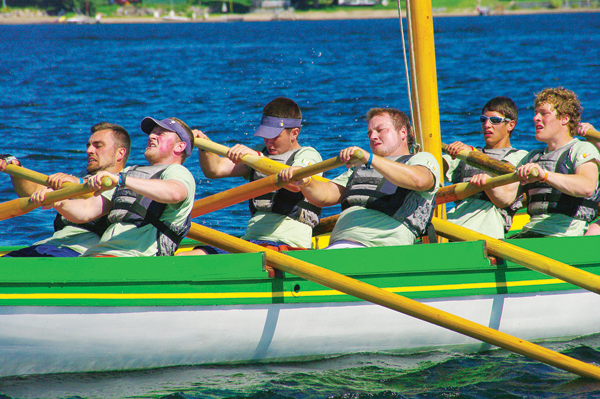
The International Contest of Seamanship has travelled from France (2000), Maine U.S.A (2002), Wales (2004), Italy (2006), Finland (2008), to Midland (2010) and Bantry is set to host the Atlantic Challenge International Contest of Seamanship in 2012. For more information, log onto www.bantry2012.ie or www.atlanticchallenge.org Click this link for Irish Rowing details
Click this link for the Latest Rowing News



























